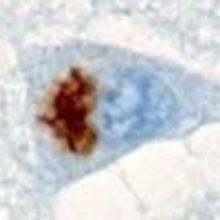Login
Subscribeneurodegeneration, cell & molecular biology

Infographic: Modeling Neurodegenerative Diseases with Yeast
Mahlon Collins | Oct 1, 2021 | 3 min read
Conservation of structures and functions between single-celled fungi and human cells allow researchers to probe the brain.

Yeast Models Provide New Insights into Neurodegenerative Diseases
Mahlon Collins | Oct 1, 2021 | 10+ min read
The single-celled fungus allows researchers to study Alzheimer’s, Parkinson’s, ALS and other brain diseases with unparalleled speed and scale.

Sex of Human Cells Matters in Studying Neurological Disease
Amanda Heidt | Mar 18, 2021 | 5 min read
Authors of a new review urge researchers to consider how the chromosomal sex of a cell affects experiments in research on neurodegeneration.

The Scientist Infographics: Editor’s Picks of 2019
Jef Akst | Dec 18, 2019 | 3 min read
This year’s most beautiful illustrations covered topics including the molecular underpinnings of Parkinson’s disease and strategies for tracking marine organisms around the world’s oceans.

Image of the Day: DISCO Tissue Clearing
Emily Makowski | Oct 22, 2019 | 1 min read
New methods of visualizing tissue are presented at the Society for Neuroscience meeting.

Tau Linked to RNA Splicing Errors in Flies
Emily Makowski | Oct 8, 2019 | 2 min read
In brain samples from people with Alzheimer’s disease, the protein aggregates more strongly bound proteins involved in processing RNA, the same study finds.

Is It Time to Rethink Parkinson’s Pathology?
Ashley Yeager | Oct 1, 2019 | 10+ min read
New evidence points to a waste-clearing problem in patients’ cells, rather than the accumulation of protein tangles, as the root cause of the neurodegenerative disease.

Air Pollution May Damage People’s Brains
Catherine Offord | Oct 1, 2019 | 10+ min read
Contaminants in the atmosphere appear to have harmful effects on neurodevelopment and cognitive function.

Infographic: Is Cellular Waste at the Root of Parkinson’s Disease?
Ashley Yeager | Oct 1, 2019 | 1 min read
Damage to the lysosome, the organelle that removes excess proteins, lipids, and other materials, might be at the root of the disease.

Image of the Day: Alzheimer’s Genes
Nicoletta Lanese | Aug 19, 2019 | 1 min read
Mutations within the MS4A gene cluster have been linked to changes in protein levels that affect disease risk.

Gum Disease Could Drive Alzheimer’s: Study
Ashley Yeager | Jan 24, 2019 | 2 min read
An enzyme of the bacteria Porphyromonas gingivalis has been found in the brains of patients with the disorder, and causes neurodegeneration in mice.

BRCA1 Linked to Alzheimer’s
Jef Akst | Nov 30, 2015 | 1 min read
The cancer-related protein BRCA1 is important for learning and memory in mice and is depleted in the brains of Alzheimer’s patients, according to a study.

Cysteine Aids Mice with Huntington’s
Kerry Grens | Mar 31, 2014 | 1 min read
Rodent models of Huntington’s disease show dysfunctional cysteine production, and adding the amino acid to their diets seems to relieve symptoms.

Non-coding Repeats Cause Peptide Clumps
Ruth Williams | Feb 7, 2013 | 3 min read
Protein aggregates in the brains of some people with dementia or motor neuron disease have a surprising origin.

A Root Cause of Parkinson’s
Ruth Williams | Nov 15, 2012 | 3 min read
Misfolded α-synuclein proteins promote the spread of Parkinson’s pathology in mouse brains.
Brain Proteins May Be Key to Aging
Bob Grant | Feb 8, 2012 | 1 min read
Deterioration of long-lived proteins on the surface of neuronal nuclei in the brain could lead to age-related defects in nervous function.
